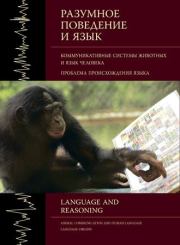Жанна Ильинична Резникова - Язык животных: подходы, результаты, перспективы…
 | Название: | Язык животных: подходы, результаты, перспективы… |
Автор: | Жанна Ильинична Резникова | |
Жанр: | Языкознание, Биология | |
Изадано в серии: | неизвестно | |
Издательство: | изд-во Института компьютерных исследований | |
Год издания: | 2004 | |
ISBN: | неизвестно | |
Отзывы: | Комментировать | |
Рейтинг: | ||
Поделись книгой с друзьями! Помощь сайту: донат на оплату сервера | ||
Краткое содержание книги "Язык животных: подходы, результаты, перспективы…"
В последние 30 лет изучение языкового поведения животных открыло совершенно новые перспективы для познания их высших психических функций. Речь идет об использовании символов, категорий, и даже способностей скрывать свои «мысли» и «намерения». Иными словами, изучая возможности коммуникации животных, мы раскрываем дополнительные возможности их интеллекта.
Читаем онлайн "Язык животных: подходы, результаты, перспективы…". [Страница - 18]
Boysen S.T., Berntson G.G., Hannan M.B., Cacioppo J.T. 1996. Quantity-based interference and symbolic representation in chimpanzees (Pan troglodytes). Exp. Psychol.: Anim. Behav. Process. V. 22, N1, p. 76—86.
Cheney, D.L., Seyfarth R.M. 1990 How monkeys see the world. University of Chicago Press.
Cheney, D.L., Seyfarth R.M. 1997. Why Animals Don’t Have Language. The Tanner Lectures on Human Values. Cambridge University, p. 1—37.
Chevalier-Skolnikoff S.1976. The ontogeny of primate intelligence and its implication for communicative potential: A preliminary report. In: S.R. Harnad, H.D. Steklis, Lancaster (Eds.). Annals of the New York Academy of Sciences, V. 280, «Origins and Evolution of Language and Speech», New York, p. 173—211.
Chomsky N. 1972. Language and mind. New York, p. 250.
Chomsky N. 1975. The Logical structure of linguistic theory. University of Chicago Press.
Chomsky N. 1986. Knowledge of Language. Greenwood.
Esch H. 1964. Beitrige zum Problem der Entfernungwesung in den Schwanzeltдnzen der Hinigbiene. Z. Vergl. Physiol., V. 48, s. 534—546.
Evans C., Evans D. 1999. Chicken food calls are functionally referential. Animal Behaviour, V. 58, p. 307—319.
Evans W.E., Bastian J. 1969. Marine mammal communication: social and ecological factors. In: H.T. Andersen (Ed.), The Biology of Marine Mammals, New York Acad. Press.
Fouts R.S. (with S.T. Mills) 1997. Next of Kin: What Chimpanzees Have Taught Me About Who We Are. Whashington.
Fouts R.S., Fouts D.H. 1993. Chimpanzees’ Use of Sign Language. In: The Great Ape Project: Equality Beyond Humanity. Ed. P. Cavalieri and P. Singer. New York: St. Martin’s Press, p. 28—41.
Frisch K., Von. 1923. Ьber die Spriche der Bienen. Zool. Jahrb. V. 40, p. 1—119.
Frisch K., Von. 1950. Bees, their vision, chemical senses and language. Cornell Univ. Press.
Frisch K., Von. 1956. The «language» and orientation of the bees. Proc. Amer. Phil. Soc. V. 100, p. 515—519.
Frisch K., Von. 1967. The Dance Language and Orientation of Bees (trans. By Chadwick K.E.). Cambridge, Mass., Harvard Univ.Press.
Gardner B.T., Gardner R.A. 1969. Teaching sign language to a chimpanzee. Science, N165, p. 664—672.
Gould J.L. 1976. The dance language controversy. Q. Rev. Biol., V. 57, p. 211—244.
Hauser M.D. 2000. A Primate Dictionary? Decoding the function and meaning of another species’ vocalizations. Cognitive Sciences, V. 24, N3, p. 445—475.
Herman L.M. 1986. Cognition and language competence in bootlenosed dolphins. In: Dolphin cognition and behaviour. New York: Hillside, p. 221—252.
Hockett C.D. 1960. The origin of speech. Scientific American, N203, p. 99—196.
Hьlldobler B., Wilson E.O. 1990. The Ants. Berlin: Springer Verlag, 732p.
Janik V.M., Slater P.J.B. 1997. Vocal learning in mammals. Advances in the Study of Behavior, V. 26, p. 59—99.
Jьrgens U. 1989. Language Evolution. In: Speech and Language. Readings from the «Encyclopedia of Newroscience» (D. Kimura, ed.). Bikkhiuser, Boston-Basel. p. 9—34.
Kimura D. 1979. Neuromotor mechanisms in the evolution of human communication. In: Neurobiology of Social Communication in Primates. Steklis H.D, Raleigh M.J. (eds). New York Academic Press. p. 197—219.
Lenoir A., Jasson P., 1982. Evolution et rule des des communications antennaries ches les Insectes Sociaux. In: Social Insects in the tropics. P. Jasson (ed.). Univ. Paris-Nord, p. 157—180.
Lindauer M. 1961. Communication among Social Bees. Cambridge, Massachusetts, Harvard Univ. Press, p. 230.
Menzel, Jr., E.W. 1974. A group of young chimpanzees in a one-acre field. In: Behavior of Nonhuman primates. Schrier A.M., Stollnitz F. (eds.), V. 3. New York: Academic Press, p. 83—153.
Michelsen A. 1993. The transfer of information in the dance language of honeybees: progress and problems. J. Comp. Physiol. A, Sensory, Neural and Behavioural Physiology. V. 173, p. 135—141.
Michelsen A. 1998. The dance language of honeybees: recent findings and problems. In: Peter Marler Book, MIT Press.
Michelsen A., Andersen B.B., Kirchner W., Lindauer M. 1990. Transfer of information during honeybee dances, studied by means of a mechanical model. In: Sensory systems and communication in Arthropods. Advanced in Life Sci., Basel, Birkhiuser Verlag, p. 284—300.
Mitani J. 1996. Comparative studies of African ape vocal behaviour. In: Great Ape Societies. Eds. W.C. McGrew, L.F. Marchant and T. Nishida. Cambridge: Cambridge University Press. p. 203—235.
Morel L. 1986. Ontogenesis of the antennal activity associated with food transfer in the callow worker ant. Develop. Psychobiol., V. 10, N5, p. 413—426.
Patterson F. 1979. Talking gorillas as informants: question posed by Jane Goodall regarding wild chimpanzees. Gorilla, N2, p. 1—2.
Patterson F., Linden E. 1981. The Education of Koko. New York: Holt, Rinehart and Winston.
Pepperberg I.M. 1987. Acquisition of the same — different concept by an African grey parrot (Psittacus errithacus): Learning with respect to categories of colour, shape and material. Anim. Learn. and Behav., V. 15, p. 423—432.
Premack D. 1971. Language in chimpanzee? Science, N172, p. 808—822.
Reznikova J. (Zh.) 1982. Interspecific communication between ants. Behaviour, N80, p. 84—95.
Rumbaugh D.M. 1977. Language Learning by a Chimpanzee. New York Acad. Press, p. 250.
Rumbaugh D.M., Gill T.V. 1977. Lana's Acquisition of Language Skills. In: Language Learning by a Chimpanzee: The Lana Project. Ed. D.M. Rumbaugh, New York: Academic Press, p. 165—192.
Savage-Rumbaugh E.S. 1986. Ape Language: From Conditioned Response to Symbol. New York: Columbia University Press.
Savage-Rumbaugh S., Lewin R. 1994. Kanzi: The Ape at the Brink of the Human Mind. New York: John Wiley amp; Sons.
Seyfarth R.M., Cheney D.L. 1980. The Ontogeny of Vervet Monkey Alarm Calling Behaviour: A Preliminary Report. Z. Tierpsychol. Bd. 54, p. 37—56.
Shannon C.E. 1948. A mathematical theory of communication. Bell System Techn. J., V. 27, p. 623—656.
Temerlin M.K. 1975. Lucy: Growing up Human. Palo Alto, Calif.: Science and Behaviour Books.
Terrace H.S. 1984. Simultaneous chaining: The problem it poses for traditional chaining theory. In: M.L. Commons, R.J. Herrnstein, A.R. Wagner (Eds.). Quantitative Analyses of Behavior: Discrimination Processes. Cambridge, MA: Ballinger Publishing Co. p. 115—138.
Theberge J.B., Pimlott D.H. 1969. Observations of wolves at a rendezvous site in Algonquin Park. Can. Field Nat. V. 83, N2, p. 122—128.
Wasmann E. 1899. Die psychischen Fihigkeiten der Ameisen. Zoologuca, Bd. 26, s. 1-133.
Yerkes R.M. 1916. The Mental Life of Monkeys and Apes, a Study of Ideational Behavior. Behavior Monographs, Baltimore.
Zuberbьhler K.2000b. Referential labelling in Diana monkeys. Animal Behaviour, V. 59, p. 917—927.
2006:03:02
--">
Книги схожие с «Язык животных: подходы, результаты, перспективы…» по жанру, серии, автору или названию:
 |
| Итало Кальвино, Илья Михайлович Франк - Итальянский язык с Итало Кальвино. Марковальдо, или времена года в городе / Italo Calvino.... Жанр: Языкознание Серия: Метод обучающего чтения Ильи Франка |
 |
| Гарольд Дуайт Лассуэлл - Язык власти Жанр: Языкознание Год издания: 2006 |
 |
| Мария Валерьевна Вербицкая, Ольга Сергеевна Миндрул, Стюарт Маккинли и др. - Английский язык. 8 класс. Учебник для учащихся общеобразовательных организаций (3-е издание,... Жанр: Учебники и пособия: прочее Год издания: 2018 Серия: Российский учебник: forward |
 |
| Умберто Эко - Сказать почти то же самое. Опыты о переводе Жанр: Языкознание Год издания: 2015 |
Другие книги автора «Жанна Резникова»:
 |
| Жанна Ильинична Резникова - Экспериментальные исследования способностей животных к количественным оценкам предметного мира Жанр: Биология |
 |
| Жанна Ильинична Резникова - Язык животных: подходы, результаты, перспективы… Жанр: Биология Год издания: 2004 |




